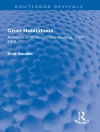Commentary on memorials to the Holocaust has been plagued with a sense of “monument fatigue”, a feeling that landscape settings and national spaces provide little opportunity for meaningful engagement between present visitors and past victims. This book examines the Holocaust via three sites of murder by the Nazis: the former concentration camp at Buchenwald, Germany; the mass grave at Babi Yar, Ukraine; and the razed village of Lidice, Czech Republic. Bringing together recent scholarship from cultural memory and cultural geography, the author focuses on the way these violent histories are remembered, allowing these sites to emerge as dynamic transcultural landscapes of encounter in which difficult pasts can be represented and comprehended in the present. This leads to an examination of the role of the environment, or, more particularly, the ways in which the natural environment, co-opted in the process of killing, becomes a medium for remembrance.
Tabela de Conteúdo
List of Illustrations
Preface
Acknowledgments
Introduction
PART I: BUCHENWALD
Chapter 1. Defining and Redefining Buchenwald
Chapter 2. Semprun’s Buchenwald
Chapter 3. Buchenwald to New Orleans
PART II: BABI YAR
Chapter 4. Marginalized Memories
Chapter 5. Babi Yar’s Literary Journey
Chapter 6. Kiev to Denver
PART III: LIDICE
Chapter 7. Between the Past and the Future
Chapter 8. Lidice Travels
Chapter 9. Twinning Lidice
Conclusion: Travelling to Remember
Bibliography
Index
Sobre o autor
Jessica Rapson is a Lecturer in the Department of Culture, Media and Creative Industries at King’s College London. She is co-editor, with Lucy Bond, of The Transcultural Turn: Interrogating Memory Between and Beyond Borders (de Gruyter 2014).












